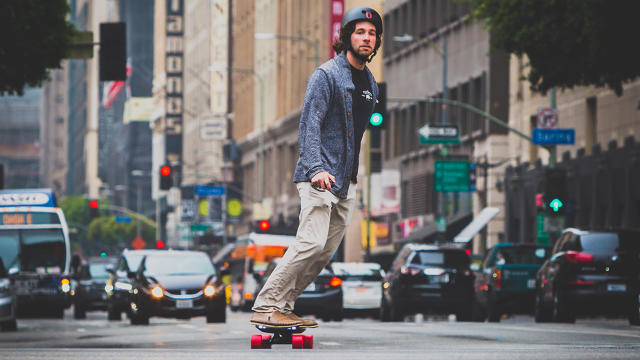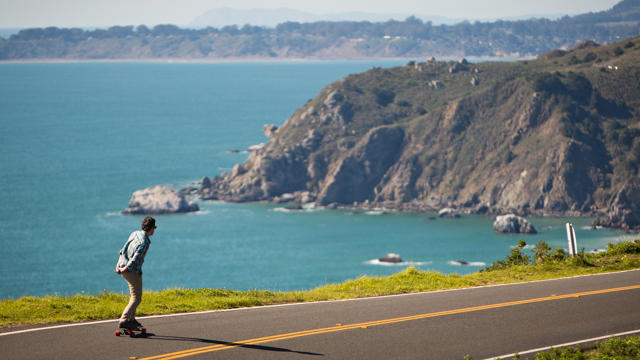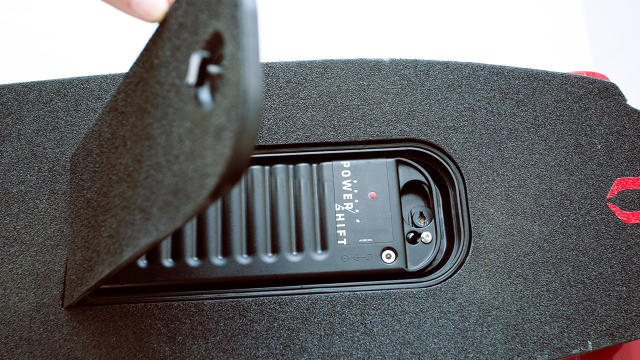A Skateboard Startup’s Radical Ambition: Disrupting Urban Transit
Two types of technologists bump into each other in Santa Cruz, California. One group made fortunes in Silicon Valley before moving 45 miles over the mountains to raise kids or surf or generally enjoy life in the sleepy beach town. The other type are guys who want to skip the Palo Alto part and launch their startups right where they want to live.
Ryan Evans, the 32-year-old CEO of an electric skateboard company called Inboard Technology, belongs to the second group. A former competitive kiteboarder, he commutes to work on his company’s first product, the M1, and envisions a future where commuters all over the world do the same.
To get there, he needs support from potential investors who tend to be guys in that first group. (They’re rarely the type to skateboard to work.)
When Toby Corey, a president of global sales at SolarCity, the solar panel maker recently acquired by Tesla, called to see if Evans wanted to surf, there was only one answer. It was the end of a busy Friday at the end of a busy week and there was no swell and no waves anywhere in Santa Cruz County. Still, the answer was yes.
“I would go paddle out into a swamp if that’s what he wanted to do,” Evans told his cofounder, Inboard’s chief tech officer, Theo Cerboneschi. “If he said, ‘I’m thinking about building sandcastles on the beach, wanna come?’ I’m there. No question.”
Cerboneschi, another former competitive kiteboarder, declined an invite to join the waveless surf session and went back to his computer, where he continually refines the product he started on his balcony as a college freshman in Southern California. Dozens of iterations later, the electric board is the first of what the Inboard team hopes will become a full line of personal mobility devices that may include scooters and wheelchairs. “Our grandiose vision probably four or five years from now is to have different form factors that meet everybody’s needs,” Evans says.
Evans grew up in Chicago and Cerboneschi in Annecy, France, near the Swiss border. The two met through a kiteboarding company where Evans ran North American sales and Cerboneschi was a sponsored rider. Cerboneschi, 25, moved to the U.S. to study engineering when he was 18. During his first year, his bike was stolen, so he started skateboarding to class but hated showing up sweaty. An early fan of drone technology, he experimented with inserting a drone motor into a skateboard wheel and rode his creation to school.
When he transferred to University of Colorado at Boulder, Cerboneschi continued to ride a motorized deck around the sloping 600-acre campus.

“People were pretty crazy about it,” he said. “I got stopped so any times. ‘Where can I buy this?’ ‘You can’t buy it.’ ‘I’ll buy it from you.’”
After three years of college, Cerboneschi dropped out and went back to France to focus full-time on the board. When he had a prototype he liked, six months later, he moved back to the U.S. and brought the board to Evans to see if he was interested.
“I rode 10 meters and turned around and was like, ‘This is it,’” Evans said. “First of all, it was fun. And then it was, What can I do with this? I no longer have to drive . . . it’s more cost-effective, it’s lighter, it’s cheaper, it’s more environmentally friendly.”
And that’s the promise of personal mobility vehicles that has raised eyebrows of city planners and investors alike. Also called rideables, the category includes electric bikes, scooters, and skateboards—all of which can help alleviate traffic, pollution, and the parking problems that cities face. For consumers, rideables can supplement a car or replace it, depending on the location. The market is projected to expand briskly: Already, global annual sales of electric bikes top $16 billion, while sales of self-balancing scooters, or hoverboards, approach $2 billion. The electric skateboard market could soon rival that of hoverboards.
Inboard launched in the spring of 2015 with a Kickstarter campaign that raised more than $400,000 from 551 backers, followed by a “substantial” investment from Central Coast Angels. By the end of 2016, it had shipped more than 24,000 boards across the U.S., into Europe and Asia, and counted 15 full-time employees. And over the summer, they reached what would be surreal heights for any company: an invitation to pitch their vision to the investors of Shark Tank, and to a television audience of millions.

Inboard’s grand plan is loosely based on Elon Musk’s strategy with Tesla. Musk first proved his company’s cool with the $100,000 roadster, then flashed its technical prowess with the $70,000 Model S sedan, before launching the every-person car with the $35,000 Model 3. With the M1, Inboard hopes to snare early adopters who the company identifies as mostly men between 30 and 55 years of age who live in urban areas and earn more than $130,000 annually. According to Inboard’s analysis, a million people fit that description, and with more than twice the median income in the U.S., they can afford the $1,399 price tag. As the price drops, the potential customer base grows. If the board costs less than $1,000, college kids are more likely to buy it, and at a price point under $600, high schoolers get in on it.
If all goes as planned, the board fits into a transportation ecosystem that, as the world continues to rapidly urbanize, is evolving to include ride shares, public transportation and possibly autonomous vehicles. To ambitious electric skateboard entrepreneurs like Inboard’s founders, a good electric skateboard could be an answer to the so-called “last-mile problem”—how to get home from the train station, for instance—and one that’s more portable and packable than a bicycle. Last year, Audi introduced a concept car at the Beijing Autoshow that featured an electric longboard tucked into the rear bumper. Representatives from both Volvo and JetBlue have also dialed Inboard’s offices to learn more about the M1. “They’re looking to see how the markets mature and are asking, ‘How can we pair a smart car with emerging technologies and also have a foot in the game with rideable technologies?’” says David Evans, Ryan’s older brother and Inboard’s chief marketing officer.
Still, electric skateboards are not a sure bet in a multimodal transportation future. Derek Kerton, chairman of the Silicon Valley AutoTech Council, sees plenty of bumps in the road. Kerton is charged with helping companies bring innovation to market. He mostly works with car companies, and he’s yet to meet a rideable he won’t try. His garage is filled with e-bikes and scooters. An electric skateboard would be easier to carry onto a train or lug up a flight of stairs, but Kerton believes people will forgo the convenience for safety. “With electric bikes, many people can ride so the falls are few,” he says. “Skateboards are on the other end of the ‘Will I fall?’ spectrum. You will possibly fall every day.”
Unless, of course, you are already a serious skateboarder. An estimated 5.6 million Americans buy and ride traditional human-powered skateboards. They spend roughly $1 billion on their boards annually, but the purpose tends to be recreation rather than transportation.
“Skaters don’t really skate to get places,” Pete Whitley, who promotes public skateparks as program director with the Tony Hawk Foundation, told me. (Research on the use of skateboards as transportation remains minimal.) When asked if skateboarders might use motorized boards to get around, Whitley was skeptical. “It’s like a snowboard with an engine on it. There’s something inherently offensive about it.”

If Inboard wants to become the Tesla of rideables, the company has to carve a path between one crowd that fears falling and another that fears looking uncool, while simultaneously beating its competitors to the multimodal future.
Boosted Boards, their best known competitor, launched its Kickstarter campaign in 2012, four years before Inboard, with a similarly priced electric board and similar ambitions to disrupt your commute. Boosted has what some say is clunkier technology—an external motor with a belt drive instead of an in-wheel motor—but offers a 2,000-watt motor that allows it to power up steeper hills than Inboard’s 1,600 watts. But two reports of smoking batteries in second-generation Boosted boards—apparently caused by water creating “a short-circuit in the battery’s electronics,” said the company—forced it to stop shipping new boards and issue a voluntary recall on battery packs they’d already sold. On January 12, the Consumer Product Safety Commission officially issued a recall for the battery pack, and Boosted announced it was planning to resume shipping boards in February. “Safety is a top priority for us,” Boosted CEO Sanjay Dastoor said in November. “We’re sorry for the inconvenience to our customers and look forward to getting them riding again soon.”
Boosted’s battery problems and the few-month hiatus may have hurt the company’s lead and opened a lane for competitors like Acton Global Sports. The Mountain View-based company recently raised $1.3 million through Indiegogo for its line of Blink Boards, which are priced from $250 to $1,700. Acton’s design includes in-wheel motors, but Inboard’s Carboneschi thinks it’s a different beast. “They’re not an engineering company,” he says dismissively. “Basically what they do is source products from China and put their brand on it.”

It may be cheaper to build a board by sourcing motors from one company, the motor controller from another, and the deck from a third, but Inboard chose to design, build, and assemble all of its components in San Francisco. From the start, the company decided it would build all of its own components from scratch. This gives Carboneschi greater confidence that they will avoid “a thermal runaway event,” as smoking batteries are known in the industry.
“The system doesn’t perform as well if all the parts come from different suppliers,” says Carboneschi. “That only way you get the feel we wanted is by making everything yourself.”
The feel of the board is surprisingly responsive, even for a neophyte. Wearing a helmet and controlling my speed with the handheld remote, I safely, if not gracefully, took an M1 for a test ride along West Cliff Drive in Santa Cruz, threading through the crowd of walkers, runners, and tourists enjoying the ocean view. The M1 rides like a traditional skateboard—minus the physical labor—and goes 20 mph for 7-10 miles on a single battery charge. The battery is easily swapped out for another 7-10 miles, and it can be recharged in 90 minutes. The company’s mission statement is “to use technology to spread the feeling of stoke.”
Whether the look and feel of the first product is enough to get that done is still an open question. In a segment filmed in June, the Evans brothers and Inboard’s financial officer pitched their product to Shark Tank‘s panel of celebrity investors on a soundstage in Culver City. After their well-honed pitch—one they stayed up practicing until 3 a.m.—the Inboard team offered 4% of the company valued at $18 million. The Sharks were intrigued enough to grill the team about sales, market-size and distribution for over an hour.
In the final aired segment, the exchange has been edited down to just five minutes; we also see investor Kevin O’Leary take the board for a spin and then team up with Lori Greiner to make an offer. (Robert Herjavec doesn’t “buy into” the idea of using a skateboard for mass transportation, and, along with Chris Sacca and Marc Cuban, declines to invest.) The remaining Sharks stop short of buying equity in the company and opt for a less risky route: a 36-month loan of $750,000 at 9% in exchange for 4% of the company. The Inboard team grins and accepts.
Back in Santa Cruz in December, the company hosted a viewing party in a tent at the hip Hotel Paradox. The space was packed with technologists who made money over the hill, and those who wanted to make it locally. All of them looked like Inboard’s early adopters—mostly male, athletic, and sporting high-priced gear from Arc’Teryx and Patagonia. People like Corey, the Solar City executive, who by then had become another of the company’s angel investors. The Sharks may have been ambivalent, but this crowd was not. “When can I get my board?” was the first question from the floor.
Fast Company , Read Full Story
(73)



